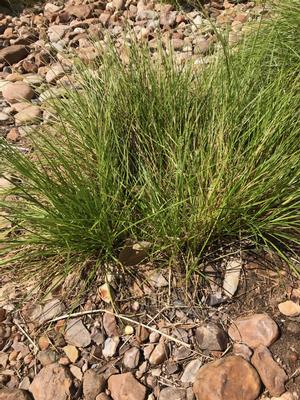Printed at http://www.newmoonnursery.com/index.cfm/
Carex divulsa
grassland sedge
Native to Europe and Asia
FIRST IMPRESSIONS: Carex divulsa is a perennial sedge that matures into fine textured arching clumps. The bright green foliage is evergreen. In late spring dainty bronze flower spikes are displayed above the leaves. Plants adapt to sunny or shaded exposures with dry, moist or wet soils. This sedge is used in the landscape as a groundcover or lawn alternative.
HABITAT & HARDINESS: Carex divulsa is an exotic sedge that occurs from Europe and North Africa to Central Asia. This species is naturalized in Ontario, Pennsylvania, Maryland, Missouri, California and in Argentina, Australia and New Zealand.
Carex divulsa was said to be introduced into the California nursery trade by John Greenlee in 1990. The plant was called Berkeley sedge or Berkeley Star sedge because it was originally obtained from a nursery in Berkeley, California. Since Carex divulsa was naturalized in California, it was mis-identified as a native foothills sedge called Carex tumulicola. It was sold in nurseries as a native sedge and widely planted in native landscapes. In 2005, the sedge was correctly keyed and outed as an exotic.
In California, Carex divulsa is naturalized on open grassy slopes, open woodlands, fields, pastures and coastal meadows. The species differs culturally from the California native Carex tumulicola because it spreads more aggressively and is more cold tolerant.
Plants are hardy from USDA Zones 4-9.
PLANT DESCRIPTION: Carex divulsa grows in attractive dark green mounds of delicate arching foliage. The fine-textured leaves are evergreen and only about 1/8” wide.
In spring, plants produce slender arching culms up to 2’ long. Each culm contains 4-8 bronzy spikelets. Each spikelet contains 3-12 pale yellow perigynia.
As the seed mature, the spikelets transform into small dark brown seed clusters.
This graceful sedge is 1-3’ tall with an equal spread.
CULTURAL & MAINTENANCE NEEDS: Carex divulsa prospers in filtered sun or part shade and in dry, moist or wet soils.
Plants tolerate full sun, full shade heat, humidity, clay, sand, dry shade, occasional mowing and foot traffic.
Established plants are drought tolerant, pest resistant and unpalatable to deer and other herbivores.
When used as a lawn substitute, Carex divulsa can be mown occasionally for a manicured appearance or left unmown for a lush mounded look. Plantings will tolerate a good bit of foot traffic but if the lawn is traversed daily, stepping stones should be added.
In wet areas or irrigated sites, plants tend to reseed and should be deadheaded if this is an issue.
LANDSCAPE USES: Carex divulsa is a valuable Groundcover, Edging or Lawn Substitute. This sedge is lovely when Grouped or Massed with spring wildflowers or low growing bulbs or ferns. The unique leaf texture allows this sedge to serve as an eye catching Accent. Plants provide Erosion Control and Winter Interest and are appropriate for Deer Resistant Plantings, Low Maintenance Plantings, Meadows, Rain Gardens, Rock Gardens and Shade Gardens.
COMPANION & UNDERSTUDY PLANTS: Suitable garden companions for Carex divulsa could include Aster divaricatus, Deschampsia caespitosa, Eupatorium perfoliatum or Rudbeckia maxima.
If a substitute is needed, Carex socialis could be substituted in a moist or wet site. In dry shade, Carex pensylvanica could fill in as a lawn alternative.
TRIVIA: Carex divulsa is also known as European gray sedge.
Height:
1-3 ftSpread:
1-3 ftSpacing:
18-24 inUSDA Hardiness Zone:
4-9Bloom Color:
GreenCarex divulsa Characteristics
Attracts Wildlife
- Songbirds
- Pollinators
Attributes
- Rock Garden
- Ground Cover
- Evergreen
- Drought Tolerant
Exposure
- Full Sun to Partial Shade
Flowering Months
- June
- May
Foliage Color
- Green
Grass Season
- Cool Season Grass
Groundcover Foot-Traffic Tolerances
- Heavy
Growth Rate
- Medium
Lawn Replacement or Groundcover
- Groundcover
- Lawn Replacement
Season of Interest (Foliage)
- Winter
- Fall
- Summer
- Spring
Soil Moisture Preference
- Moist/Well-Drained

